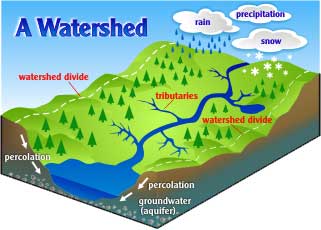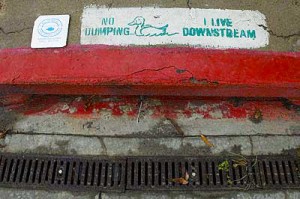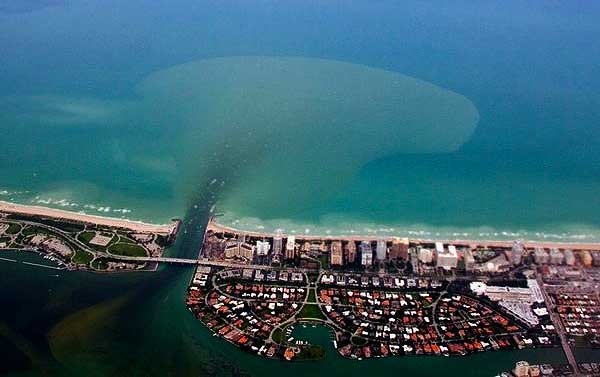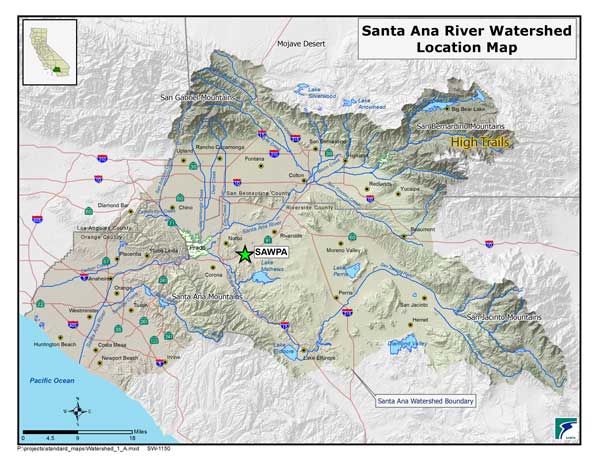Before arriving at High Trails, I worked for the Philadelphia Water Department and The Philadelphia Wooden Boat Factory. These experiences have exerted a gravitational pull on me to everything and anything that pertains to water. Living in a society that seems to circle around problems, like an endlessly rotating merry go round; I strive to focus on solutions and education. The beautiful thing about education is that it is a domino effect and our students are the catalysts to spread the word. Since most of our students live in cities, I’d like to focus on solutions pertaining to urban watersheds.
What’s a Watershed?
 A watershed is all the area of land where the water eventually drains into one body of water. This body of water can be a river, lake, stream, or aquifer where the community may get its drinking water. When it rains in a natural watershed, the water gets cleaner as it trickles down from the tippy tops of mountains through trees, plants, and thick forest ground cover into its final body of water. This is because flora and the layers of forest floor help with detoxification. They even use these chemicals as food. In an urban watershed, water carries pollutants down paved surfaces into storm drains that connect to our waterways.
A watershed is all the area of land where the water eventually drains into one body of water. This body of water can be a river, lake, stream, or aquifer where the community may get its drinking water. When it rains in a natural watershed, the water gets cleaner as it trickles down from the tippy tops of mountains through trees, plants, and thick forest ground cover into its final body of water. This is because flora and the layers of forest floor help with detoxification. They even use these chemicals as food. In an urban watershed, water carries pollutants down paved surfaces into storm drains that connect to our waterways.
We all live in a watershed.
 Watersheds supply drinking water, are sites for recreation, and sustain living organisms. Over $450 billion is spent on food, manufactured goods, and tourism that depend on healthy, clean watersheds. Our daily practices within a watershed can affect the cleanliness of that water source, as well as others nearby. This is because water pathways are continuously connected. Due to the nature of the water cycle, all the water in the world is actually connected and we are drinking the same water as the dinosaurs did millions of years ago!
Watersheds supply drinking water, are sites for recreation, and sustain living organisms. Over $450 billion is spent on food, manufactured goods, and tourism that depend on healthy, clean watersheds. Our daily practices within a watershed can affect the cleanliness of that water source, as well as others nearby. This is because water pathways are continuously connected. Due to the nature of the water cycle, all the water in the world is actually connected and we are drinking the same water as the dinosaurs did millions of years ago!

This is what happens in Florida after a big storm; waste runs into the ocean.
What Can We Do?
To keep the small amount of available fresh water we have clean (.4%), we need to create components of a natural watershed in an urban watershed setting and work on reducing pollutants. Here are 10 ways to improve watershed health.
- Plant more trees and create urban gardens with local flora.
- Implement green roofs.
- Use garden chemicals sparingly; create an ecosystem that utilizes its plants, microorganisms, and bacteria for a sustainable environment.
- Water the yard as needed when the sun is not at its peak. Early morning or late in the day are the best times. Too much water can create run off, carrying chemicals into the storm drains.
- Clean up outside your home including trash, leaves, and pet waste. Organic waste can block storm drains, causing flooding. Due to its decomposition, it can also decrease oxygen levels and increase harmful bacteria in water. This hurts human, plant, and animal life.
- Position garden hoses away from paved areas to reduce water carrying pollutants in storm drains.
- Wash your car at a commercial car wash so the wastewater will be treated.
- If you change your oil at home, take it to a Household Hazardous Waste Collection facility.
- Keep your car maintained to prevent leaks.
- Rinse paint brushes with water-based paint in the sink because they are toxic when they enter the ground or storm drains.
Freshwater is essential for human, animal, and plant life. If we can apply what we learn about safe watershed practices to our lives in cities, we can create positive changes. This world is complex and interwoven, but each individual has the potential to make a small difference. These small differences create partnerships, which grow and evolve to make a much larger impact. Think conservation and preservation; do more and take less.
At High Trails Outdoor Science School, we literally force our instructors to write about elementary outdoor education, teaching outside, learning outside, our dirty classroom (the forest…gosh), environmental science, outdoor science, and all other tree hugging student and kid loving things that keep us engaged, passionate, driven, loving our job, digging our life, and spreading the word to anyone whose attention we can hold for long enough to actually make it through reading this entire sentence. Whew…. www.dirtyclassroom.com


Comments are closed.